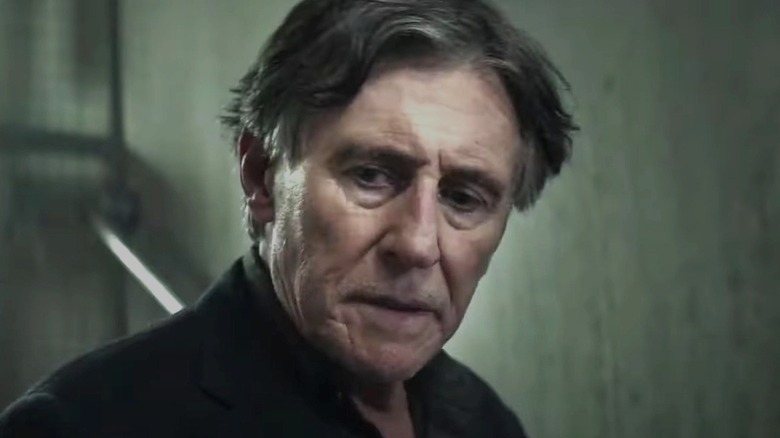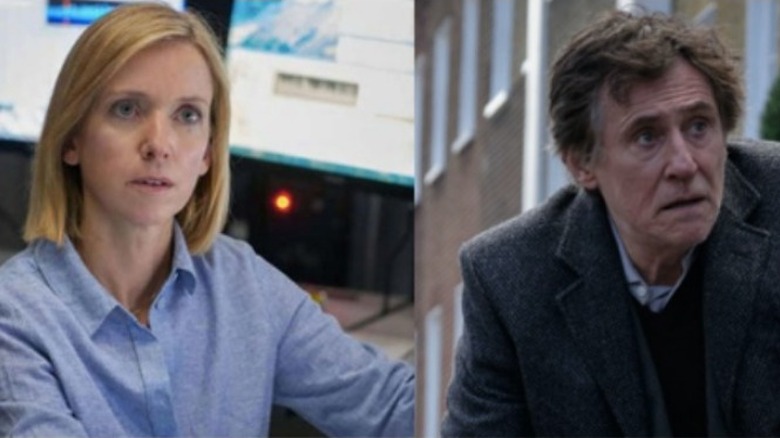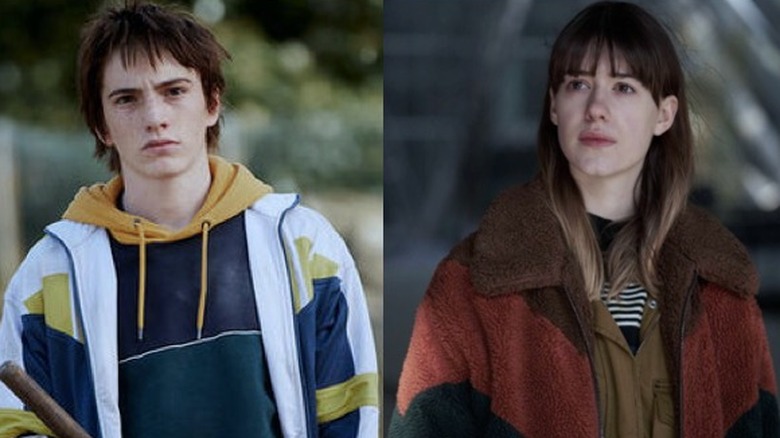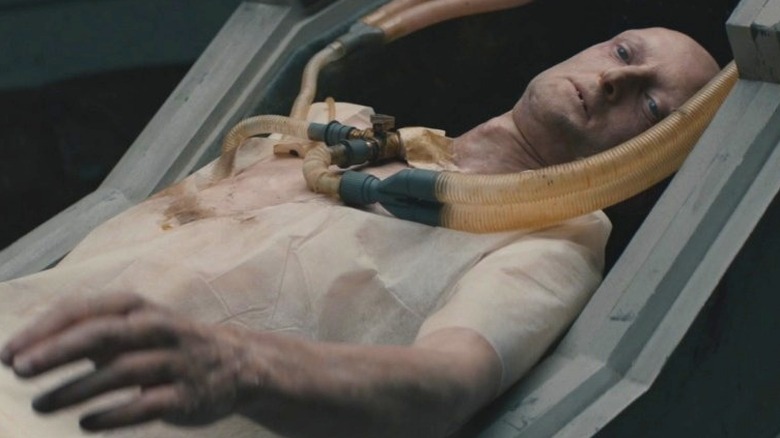The Ending War Of The Worlds Season 1 Explained
Since its publication at the close of the nineteenth century, H.G. Wells' novel, "The War of the Worlds," has been reimagined, updated, reinterpreted, and made relevant all over again by numerous creators. Most recently, writer-producer Howard Overman gave the infamous invasion story a fresh twist over the course of two eight-episode seasons on Epix. Starring Dublin-born mega-star Gabriel Byrne ("The Usual Suspects," "Vikings") and "Normal People's" Daisy Edgar-Jones, Overman's version ditches some of the story's less subtle sci-fi tropes in favor of a methodic, moody focus on interpersonal relationships, family dynamics, steep character arcs, and an exploration of what it means to be human.
Season 1 covered the initial attack of the aliens, wherein the unseen entities wipe out a massive percentage of the human population via destructive sound waves and part-mechanical, part-organic dogs similar to those in the "Metalhead" episode of "Black Mirror." The narrative then settles into a rhythm similar to other post-apocalyptic series, following nuclear pockets of survivors in England and France as they catch their breath and set off on their quest for refuge, safety, and answers. In fact, if one were to substitute zombies for the mechanical machine gun dogs, "War of the Worlds" could well be yet another spin-off of "The Walking Dead." Unlike the popular zombie franchise, though, Overman's survivors are still mostly holding on to the belief that they might be able to win this particular war, especially since a few of them appear to hold mysterious connections to the equally mysterious invaders.
In the Season 1 finale, the series pulls further away from its source material, distinguishing itself from stories of its ilk by twisting some of the genre's age-old archetypes, all while embracing some of its more timeless subtext.
War of the Worlds' finale adds a twist to the sci-fi scientist archetype
Unlike other series and films of its general persuasion, Epix's "War of the Worlds" contains not one, but two scientists from varying fields, both of whom are integral to the narrative and the theme of its Season 1 conclusion. In England, neuroscientist and professor Bill Ward (Byrne) struggles to understand the invaders' biology and neurology, while across the channel in France, astronomer and observatory head Catherine Durand (Léa Drucker) strives to understand their language, motivations, and intent. Both scientists struggle with interpersonal relationships, but in ways that are both distinct and revealing.
While Bill spends most of Season 1 attempting to get his ex-wife back (who ultimately dies in the penultimate episode anyway), Catherine is working to patch things up with the younger sister she raised following their parents' death. Bill's parental instincts are his strength, while in Catherine they appear to be her weakness. By the season finale, however, Catherine is learning to embrace her humanity (and thus, is taking a more humanistic approach to understanding the aliens, despite her fear), while Bill, after losing both his son and ex-wife, is concerned solely with figuring out the science that will help him destroy the unknown invaders. The scientists — who began as complimentary, if not mirror, images of one another — move further toward the opposite ends of their respective spectrums. Oh, and the fact that one is English and one is French certainly doesn't hurt in terms of the series' focus on opposing factions.
Emily and Sacha further connect (and repel) in the season finale
Emily (Edgar-Jones) and Sacha (Mathieu Torloting) also embody a divide in perspective and character that speaks to this embrace of dichotomy. Right down to their 2019-does-1995 color-block clothing, the series makes it clear that the teens — who've yet to meet, but who've each had romantic visions of one another — share a mysterious connection, and although that connection remains unclear by the season's end, what does become clear is just how different the pair are in terms of what they represent.
Sacha is a volatile, untrustworthy, and possibly sociopathic troubled teen, and although Emily's fellow survivors are also wary of her (thanks to her unexplained connection to the aliens), she represents the genre's classic young adult hero. Importantly, both teens have their share of domestic problems. Sacha learns he's the product of his uncle's rape of his mother — Emily, incidentally, is also not her father's biological daughter — while Emily struggles to come to terms with her guilt over what her alien connection might mean for the safety of her family.
The pair's ability to emotionally connect to the invaders also affects them differently. While Emily is relieved that her vision (a sense she lost at the age of thirteen) inexplicably returns upon the aliens' initial attack, she is equally terrified. Sacha is more interested in what his immunity to these invaders means for him, personally, and his focus quickly shifts from mere survival to tracking down the beautiful girl in his visions (Emily). Emily's courageous willingness to approach the alien ship at the finale's end is bred from her need for answers, while Sacha's willingness to accompany his mother to England, along with the man he now knows to be Emily's father, is bred from purely selfish.
Season 1's cliffhanger speaks to the series' potential overarching theme
After allowing the robot machine gun dogs (there's just no other way to describe them) to lead her to the still-unseen aliens' ship, Emily convinces her post-apocalyptic love interest Kariem (Bayo Gbadamosi) to let her board the ship alone in search of answers. After spending the majority of Season 1 tuning in and out of the invaders' emotional wave-length (a sort of "super brain" that the series likens to the kind of communication used by migratory birds), Emily is convinced that she'll be able to interpret whatever she finds in the half-submerged space craft. Unfortunately for her, what she sees leaves both her and the viewer with more questions than answers.
Rather than stumble upon a collection of little green men or giant brains attached to bodies in silver unitards, Emily meets a "creature" that, by all appearances, is nothing but a dying, sickly human. Earlier in the season, Emily says the aliens simply "want to live." Based on what she finds aboard the ship, her interpretation of their mysterious communique was correct. What's more, this pale, sunken faced human has the same concentric circle "eye" tattoo as Emily.
Although Season 1's finale provides little explanation for Emily's and Sacha's connection to the aliens, its powerful end note hints at a theme the season's focus on duality has suggested all along. That is (trite as it sounds, removed from its invasion genre context), that any two sides of a war have more in common with one another than they think. Presumably, Season 2 will further tease out this subtext, taking Wells' original focus on our fear of "the other" one step further, ultimately suggesting that said other is merely another side of the same metaphorical coin (and literal struggle).



